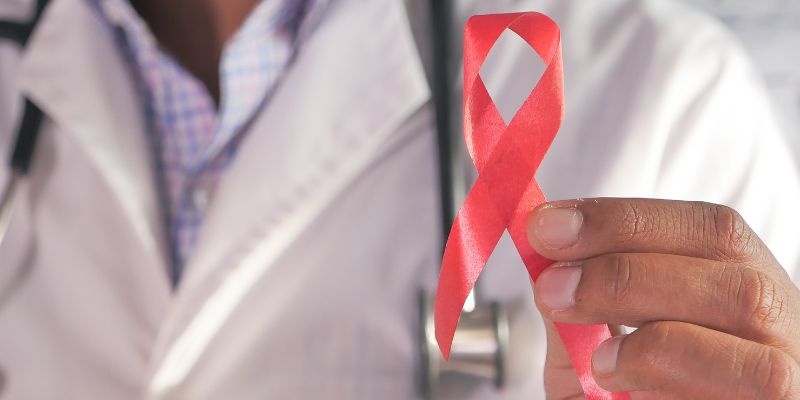Get To Know What Causes HIV? Pay Attention To These Points
Oct 13, 2023 By Madison Evans
HIV has remained a hot topic, and this global health issue is still under debate. The virus has infected more than 40 million people, yet its transmission continues in all countries.
Though the infection is not treatable, with effective prevention, treatment, and care, it can be cured to some extent. Consequently, the affected person can live a long, healthy life even with the virus.
But, before discussing the treatment, the question arises: what causes HIV? The virus is transmitted from the infected person through semen and pre-seminal fluid, blood, breast milk, rectal fluid, and vaginal fluids. If you are thinking of urine, sweat, or saliva, all of these cannot transfer HIV.
The virus has affected millions worldwide, but many misconceptions and myths exist about its transmission. If you are eager to learn how this virus is transferred, this article will answer your queries in detail. Let's learn about the common and rare ways of HIV transmission here!

What causes HIV: Transmission of HIV
HIV is transferred via different body fluids, including the blood and mother's milk. The viral is transferred from the HIV patient to the healthy person when any of these body fluids come into contact with the mucous membrane of a healthy person.
Also, the virus will be transferred if the body fluids come in contact with a healthy person's damaged tissues or skin. The syringes are another way to transfer the virus. The virus can survive on the needle for more than 42 days. Besides the injections, sharing other equipment can also be a way of viral transmission between healthy and infected persons.
Common Ways Of HIV Transmission:
Sharing different medical equipment, including syringes, needles, or other equipment, allows HIV to enter your body. It is so as any of these have blood stains and blood contains the virus. Besides that, people who inject steroids, hormones, or silicone and share the syringes can also get infected by HIV.
Less Common Ways Of HIV Transmission
HIV-positive mothers can transfer the virus to the child during pregnancy or breastfeeding. The medicines have reduced the risk of virus transfer by up to 1%. Healthcare workers are also at higher risk as they can get the virus through needlestick or sharp injuries.
Extremely Rare Ways Of HIV Transmission
Receiving the blood, tissues, or body organs from the infected person can transfer HIV if the donor is an HIV patient. But, the chances of a transfer are near impossible as blood, tissues, or organs are transferred after complete testing.
A few cases have been documented where the virus was transferred via the bite of an infected person. The bite not only caused extreme tissue damage but also transferred the virus.
Eating food that has been pre-chewed by an HIV patient can be a cause of HIV transfer. It is the most common cause of HIV in infants. It usually happens when the blood of an HIV patient's mother mixes with the infant's feed while she is chewing it.

How HIV is Not Transmitted: Ways You Need To Know About
HIV is not common to humans, but there are still many myths and misconceptions related to the transfer of HIV. Still, many people believe that touching or saliva can transfer HIV. All of these are just assumptions. The fact is that a person can transfer the virus only through blood, along with other specific types of body fluids.
Let's look over how one cannot transmit HIV:
Touching
Touching or hugging cannot transfer the virus. A person will only get infected if there are any open sores through which the exchange of body fluids occurs.
Saliva, Tears, Or Sweat
The saliva, tears, or sweat of an HIV patient will never transfer the virus. These body fluids can be the carriers of HIV only if they contain the patient's blood.
Sharing Food
The virus cannot survive on the surface of different materials, so food sharing will not cause HIV transmission. Therefore, you can share the food with your partner or friends who have HIV without any worry.
Sharing The Living Space
Sharing the living space or bathroom with any person who has HIV will not transfer the virus. But, you should not share the toothbrushes or razors as they can contain blood and transfer the virus.
Helping The Injured Person
When helping an infected person, it is better to wear the gloves. But, even if your intact skin comes in contact with the patient's blood, it will not affect you. The problem can arise only when the patient's blood comes in contact with the damaged skin or cuts of a healthy person.
Other Ways
Other ways, such as mosquito bites, water fountains, and toilet seats, cannot transfer HIV. So, there is no need to worry about them.
How is HIV Treated: A Complete Guide
Remember that the medicines of the present day cannot cure the virus completely; medication can only suppress the growth of the virus and reduce the risk of its transmission.
ART or antiretroviral therapy, which includes different medications, is recommended for HIV patients. The medicines slow down the growth rate of the virus. Though it may not cure HIV completely, the patient can survive for a long time.
Besides that, you can eat healthy and quit smoking to strengthen your immune system, which will help you fight the virus. Monitoring the CD4+ will help determine the virus's effect on your immune system. On top of all, keep your stress under control!
Conclusion:
Can touching transmit the HIV? While living in the present era, people used to believe in such myths; if you are also on their side, remember that the virus is only transmitted via blood, vaginal fluid, breast milk, rectal fluid, semen, and pre-seminal fluid.
HIV damages the immune system and eventually makes the patient fight against infections. With proper care and medication, you can survive your fight against this virus.

Uncovering the Health Benefits of Onions: Nutrition and Wellness Guide

Sodium Bicarbonate vs Table Salt: Unveiling the Contrasts Between them

A Far-Reaching Guide to Calorie Deficit

Glycolic Acid and Retinol: Is It Safe To Use Them Together?

Get To Know What Causes HIV? Pay Attention To These Points

Discover Partial Hemianopia: What, Why, and How

Understanding the Link Between Tap Water Contaminants and Cancer


